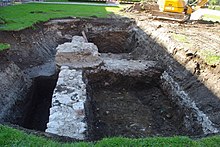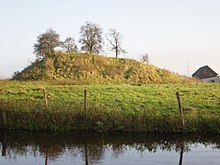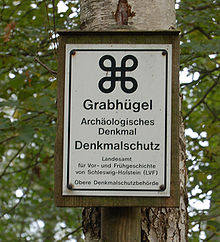Ground monument

A ground monument , also an archaeological monument , is a testimony to cultural history ( monument ) hidden in the ground . These include the remains of earlier fortifications, settlements, places of worship and burial, production facilities, businesses, traffic routes and demarcations.
A soil monument can be assessed in terms of its monument value and placed under monument protection. The protection of the ground monument can be regulated nationally or internationally (e.g. by Blue Shield International ).
Preservation features


According to this, soil monuments are movable or immovable objects hidden in the ground or in a body of water, which are testimonies, remains or traces of human (also animal and vegetable) life. Excavations, findings and finds are the main sources of scientific knowledge on these monuments.
A ground monument can be recognized
- increased concentration of finds (ceramic shards, stone artifacts)
- on landscape features (ramparts or barrows are often still visible today as elevations)
- on growth features (for example, the stalks grow less high on a grain field above hidden masonry)
- through geophysical prospecting methods
Archaeological monuments usually consist of findings and finds. In the public eye, the main focus is on the finds. However, findings often contain the more essential information and only allow a correct interpretation and classification of the findings. It makes a significant difference whether an object was found as an additive in a grave or was in a waste pit. There are also ground monuments that are completely free of finds and consist only of findings. Finds without findings, on the other hand, are pure antiques, which are generally of little scientific value.
The demarcation to architectural monuments (such as remains of the Roman Limes visible above ground , archaeological findings in a medieval church) and to natural monuments ( World Natural Heritage Site Messel Pit ) are often not clear and, in cases of doubt, arise in practice from whether there is a monument curator, an archaeologist or a paleontologist feels responsible. Archaeological monuments can form entire ensembles, such as former fortresses with main and outer bailey, settlements with houses, street systems, grave fields, churches with cemetery, monasteries with lost parts, production facilities, demarcations, etc. a. m. But it can also be individual objects like a barrow .
With regard to the protection of soil monuments, UNESCO , ICOMOS and, as a link between national processes and international regulations or military structures and civil institutions, Blue Shield International are involved internationally . This also means setting up an early warning system for the "Field Offices". Blue Shield and its national organizations have carried out projects during the wars in Iraq, Syria, Mali, Egypt and Libya, but also during natural disasters such as Haiti. To protect excavations and other cultural assets from air strikes or other military influences, so-called “no-strike lists” were and are being drawn up together with local experts and the population, transmitted to the military conflict parties and compliance with them monitored.
Legal bases
In Germany, ground monuments are defined by the monument protection laws of the federal states . Legislative competence for monument protection and preservation lies with the federal states. It is part of the so-called “ cultural sovereignty ” of the countries. There are 16 monument protection laws in Germany that define the terms cultural monument and ground monument. The laws differ in detail, but are based on similar basic principles.
All 16 laws define monument protection and the preservation of ground monuments as " public interest ". Only individual monument protection laws provide information on the age of soil monuments.
The monument law knows different regulations for ground and architectural monuments, since architectural monuments are usually visible and their concerns can be taken into account more easily than ground monuments, which are often unknown and only come to light in the course of a construction project.
In most federal states there is a “ treasure shelf ” for archaeological finds , the content of which is very different. It grants the state ownership of (selected) archaeological finds.
The European Convention for the Protection of Archaeological Heritage (Malta Convention) of January 16, 1992 (Federal Law Gazette 1994 II, p. 1286; 2002 II, p. 2709) is of international relevance .
All monument protection laws define archaeological cultural assets as ground monuments, some also - via a legal fiction - traces of plant and animal life, i.e. fossils as paleontological monuments to cultural monuments.
Excavations
An excavation can make findings and finds in a ground monument visible, but at the same time leads to the destruction of the findings. Therefore, before an excavation, it must be carefully weighed up whether the gain in knowledge that is gained by excavating and destroying the ground monument outweighs the conservation interest in its intact preservation.
For excavations, in some federal states even for research into ground monuments, excavation permits are mandatory due to the monument protection laws in Germany . They are issued by the relevant state or local authority, usually the State Office for Monument Preservation .
Even an attempt to research or excavate without official permission can constitute a criminal offense of damage to property under Section 304 of the German Criminal Code in Germany . In addition, the monument protection laws define research or excavation without official permission as an administrative offense .
Web links
- Types of ground monuments ( Landschaftsmuseum Obermain )
- State Office for Monument Preservation Hesse: Archeology in the forest. (PDF 2.9 MB) Recognizing and protecting archaeological monuments. 2005, accessed January 8, 2020 .
- KLEKs - the cultural landscape wiki - geodatabase with touristically significant soil monuments
- Database " KuLaDig " of the Rhineland Regional Association with information on cultural assets in the Rhineland and Hesse
Individual evidence
- ↑ cf. Isabelle-Constance v. Opalinski: Shots at civilization. In: FAZ , August 20, 2014; Hans Haider: Misuse of cultural goods is a criminal offense. In: Wiener Zeitung , June 29, 2012.
- ↑ Karl Habsburg in an interview "Abuse of cultural goods is punishable" in Wiener Zeitung on June 29, 2012.
- ↑ Isabelle-Constance v. Opalinski: "Shots on civilization" in FAZ from August 20, 2014.
- ↑ Sabine von Schorlemer "Destruction of cultural assets. The erasure of cultural heritage in crisis countries as a challenge for the United Nations." (2016), p. 785ff.
- ^ Cf. Corine Wegener, Marjan Otter: "Cultural Property at War: Protecting Heritage during Armed Conflict" in The Getty Conservation Institute, Newsletter 23.1, Spring 2008.
- ↑ Cf. u. a. Peter Stone: "Inquiry: Monuments Men." Apollo - The International Art Magazine February 2, 2015.
- ↑ Fabian von Posser: "World Heritage sites bombed, cultural treasures hawked." Die Welt from November 5, 2013.
- ↑ Rüdiger Heimlich: "Desert City Palmyra: Protect Cultural Heritage Before It Is Destroyed." Berliner Zeitung from March 28, 2016.

